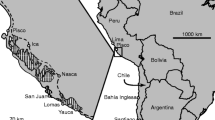Summary
Well preserved legs as well as tracks from the Lower Devonian Hunsrück Shales indicate that flexible setae encircled the distal claws of thePhacops dactylus. The setae were spread like an urabrella and used as a „snow-shoe“ when the animal walked over soft mud. Dactyli which have left their impressions in other trilobite tracks were probably provided with a variable, but smaller, number of subequal strong claws or setae fit for digging in the sand. Particular types are tentatively attributed toHomalonotus (Devonian) and to Ulaenids, which effectively ploughed through Ordovician and Silurian shallow water sands. Two larger claws and two smaller ones in front of them, as recorded in Lower Cambrian grazing tracks from Pakistan and Sweden, composed the dactylus probably of the Redlichiids. So far this is our only information about the legs of burrowing trilobites, the environment of which does not allow the preservation of the appendages themselves.
Zusammenfassung
Gut erhaltene Extremitäten und zugehörige Fährten aus dem unterdevonischen Hunsrückschiefer zeigen, daß der Dactylus vonPhacops von einem Kranz elastischer Borsten umgeben war. Dieser Borstenschirm wirkte als Schneeschuh beim Schreiten auf weichem Schlamm. Damit werden Eindrücke in anderen Trilobiten-Spuren verglichen und die zugehörigen Dactylus-Formen daraus abgeleitet. Es handelt sich dabei meist um grabende Formen (u. a.Homalonotus, Illaenus, ? Redlichia), deren Beinspitzen durch zusätzliche kräftige Krallen zu wirksamen Graborganen umgestaltet waren, sich aber in der anderen Fazies nicht körperlich erhalten konnten.
Similar content being viewed by others
Literatur
Brady, L. F.: Invertebrate tracks from the Coconino Sandstone of Northern Arizona. — J. Paleont.,21, 5, 466–472, Taf. 66–69, 2 Abb., Tulsa 1947.
Broili, F.: Ein Trilobit mit Gliedmaßen aus dem Unterdevon der Rheinprovinz. — Sitz.-Ber. bayer. Akad. Wiss., math.-nat. Abt., München 1929.
--- Weitere Funde von Trilobiten mit Gliedmaßen aus dem rheinischen Unterdevon. — Neues Jb. Miner. etc., Abt. B,64, Stuttgart 1930.
Caster, Kenneth E.: A study of the tracks ofParamphibius. — J. Paleont.,12, 1, S. 3–60, Taf. 1–13, 9 Abb., Tulsa 1938.
Dahmer, G.: Lebensspuren aus dem Taunusquarzit und den Siegener Schichten (Unterdevon). — Jb. Preuß. geol. L.-Amt,57, S. 523–539, Taf. 31–35, 2 Abb., Berlin 1937.
Lehmann, W. M.: Die Anwendung der Röntgenstrahlen in der Paläontologie. — Jber. Oberrhein. geol. Verein, 27, 1938.
Richter, Rud.: Tierwelt und Umwelt im Hunsrückschiefer; zur Entstehung eines schwarzen Schlammsteins. — Senckenbergiana,13, S. 299–342, Frankfurt 1931.
——— Marken und Spuren im Hunsrückschiefer. II. Schichtung und Grundleben. — Senckenbergiana,18, S. 215–244, Frankfurt 1936.
——— Marken und Spuren im Hunsrückschiefer. III. Fährten als Zeugnisse des Lebens auf dem Meeres-Grunde. — Senckenbergiana,23, S. 218–260, Frankfurt 1941.
Schmidt, Hermann: Die Cornberger Fährten im Rahmen der Vierfüßler-Entwicklung. — Abh. hess. L.-Amt Bodenforsch.,28, 137 S., 57 Abb., 9 Taf., Wiesbaden 1959.
Schmitgen, O.: Tierfährten im oberen Rotliegenden bei Mainz. — Paläont. Z.,9, S. 101–107, 7 Abb., Stuttgart 1928.
Sdzuy, K.: Bemerkungen zur Familie Homalonotidae. — Senck. leth.,38, S. 275–290, 1 Taf., 4 Abb., Frankfurt 1957.
Seilacher, A.: Spuren und Lebensweise der Trilobiten. — In:Schindewolf &Seilacher: Beiträge zur Kenntnis des Kambriums in der Salt Range (Pakistan). — Akad. Wiss. Lit. Mainz, Abh. math.-naturw. Kl., 1955, 342–372, 5 Abb., Taf. 16–21, Wiesbaden 1955.
——— Vom Leben der Trilobiten. — Naturwiss.,46, 389–393, 5 Abb., Göttingen 1959.
—— Strömungsanzeichen im Hunsrückschiefer. — Notizbl. hess. L.-Amt Bodenforsch.,88, 88–106, 13 Abb., Taf. 12–13, Wiesbaden 1960.
Størmer, Leif: Studies on Trilobite Morphology. I. The thoracic appendages and their phylogenetic significance. — Norsk. geol. t.,19, 143–273, 35 Abb., 12 Taf., Oslo 1939.
Author information
Authors and Affiliations
Rights and permissions
About this article
Cite this article
Seilacher, A. Form und Funktion des Trilobiten-Daktylus. Paläont. Z. 36 (Suppl 1), 218–227 (1962). https://doi.org/10.1007/BF02987905
Issue Date:
DOI: https://doi.org/10.1007/BF02987905




